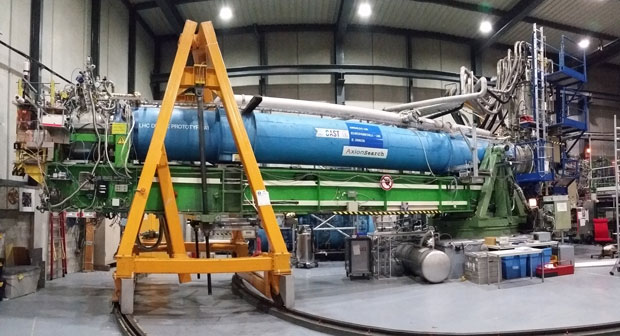Axions don’t show up yet, but that doesn’t mean they’re not out there.
Source: Ars Technica
With the identification of the Higgs boson at CERN’s Large Hadron Collider, scientists put the last piece of the Standard Model of physics in place. What they haven’t found is any hint of something beyond the Standard Model. And that hasn’t been for lack of trying. Supersymmetry, the most popular extension to the Standard Model, predicts a large collection of additional particles. We’ve looked for them and, so far, they have not shown up.
But some extensions of the Standard Model don’t predict the sorts of heavy particles that the LHC is designed to identify. Instead, they suggest there’s a very light force-carrying particle called an axion. With the right properties, an axion could solve issues in everything from particle interactions up to the scale of galaxy clusters. But its tiny mass and odd behavior means it won’t be detected in the LHC.
But that doesn’t mean the LHC’s hardware can’t find it. Clever engineers at CERN took magnets originally designed for the LHC, combined them with X-ray focusing technology originally designed for space, and built a device that could spot axions arriving here from the Sun. So far, it has seen no sign of them, which places some strict limits on the properties of these hypothetical particles.
Putting limits on our imagination
Physicists don’t just come up with hypothetical particles for fun. (Well, they might enjoy doing it, but it’s not solely for fun.) They prefer their particles to be what they call “well motivated,” meaning there’s a good reason for proposing them. In the case of axions, that motivation came from quantum chromodynamics, which describes the interactions of quarks and gluons. Axions were proposed to provide a theoretical explanation for why these particles appear to be indifferent to the direction of time (technically called “time-reversal invariance”).
Since then, other types of axions have been proposed, but they all share a critical property: they have mass (although not very much). This makes them possible dark matter candidates, since they should be present in our Universe in very large numbers.
The proposed properties of axions are critical because they help us set limits on what the particles look like. For example, if the particles are involved in quantum chromodynamics, the properties of the Universe set a limit on their mass. Similarly, if axions are involved in interactions that ensure they’re produced in stars, they would carry energy away from those stars, shortening some stages of stellar evolution. We can test this by looking at the energy balance of stars and by tracking the numbers of specific types of stars in a cluster.
One of the stranger properties of axions is their behavior in magnetic fields, which can convert axions to photons and back. That also has consequences for astronomy. Like neutrinos, axions produced in a supernova should escape the debris more readily than light, since they don’t interact with the matter there. Some of them should be converted to photons by the magnetic fields they encounter as they travel, leading to a burst of gamma rays that arrive with the neutrinos. We haven’t seen that, which sets a further limit on the properties of axions.
Magnets and telescopes
These interactions with magnetic fields also give us the chance to spot axions here on Earth. One idea is to put magnets on either side of a wall and then point an intense laser at them. The magnet on one side of the wall will convert some of the laser’s photons to axions, which can pass through the wall and get converted back by the second magnet. It will look like the photons themselves passed straight through the wall.
It’s also the principle behind the new experiment at CERN. Rather than creating its own photon source, the CERN Axion Solar Telescope (CAST) team decided to use the Sun, which should produce axions via a variety of processes. And at CERN, large magnets are relatively easy to come by. In this case, the team used a test version of one of the segments of the LHC, which contains powerful magnets to keep the particles moving around the collider.
The magnet (the large blue tube in the image above) was placed on a giant turntable that allowed it to rotate to capture an hour and a half of data at both sunrise and sunset. If axions exist, this setup should convert some of the axions produced by the Sun into X-ray photons.
To increase the signal, the CAST team turned to astronomers. X-rays are very difficult to focus, but NASA has developed a number of X-ray telescopes that it has sent to space. The team used a copy of the hardware used in the NuSTAR satellite to take any X-rays produced in the magnets and focus them on the detector hardware.
Coming up empty
With three years of data, the numbers are such that everything observed in the detectors is almost certainly background. That’s not a waste of time, though. The CAST team is pretty sure they understand where the background is coming from and can add shielding to the hardware. In addition, the experience with CAST should inform the production of a larger, next-generation version of the axion telescope, called IAXO.
It’s also not a loss from the physics perspective. The data set new limits on the coupling between axions and photons. The limits from this data are the first from a dedicated detector that are better than the ones provided by astronomy, so this represents real progress in the dedicated search for axions. Not bad for a bunch of repurposed hardware.
Source: Ars Technica

































Leave a Comment
You must be logged in to post a comment.